 Collection
All Items
Xian Tian Hu Shi Ji Lian You Ke, or The Anterior Heaven Ritual for Feeding,Saving and Refining Ghosts
Collection
All Items
Xian Tian Hu Shi Ji Lian You Ke, or The Anterior Heaven Ritual for Feeding,Saving and Refining Ghosts
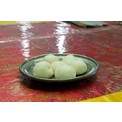
- Ritual Item: Buns for the Dead
During a salvation ritual, the ritual master turns the buns into food consumable for the ghosts according to Taoist ways. He then says the incantation while throwing the buns one by one before the altar as an offering of food for the hungry ghosts present at the ritual.
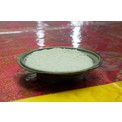
- Ritual Item: Rice Grains
During a salvation ritual, the ritual master cooks the rice on the spot in a Taoist alchemy stove. He then turns the cooked rice into food consumable for the ghosts present at the ritual according to Taoist ways.
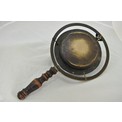
- Ritual Vessel: Dangzi
Dangzi is a ritual percussion instrument, and used together with the woodblock muyu. It is sounded by hitting a small mallet against a bronze disc. In a salvation ritual, the Inspector of Fasts usually plays the dangzi in tandem with the Chief Cantor who plays the muyu to guide the tempo of scripture chanting. This exhibit is an early ritual vessel from Sanyuan Temple in Guangzhou, now kept in Fung Ying Seen Koon.
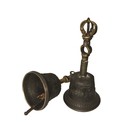
- Handheld Service Bell from Sanyuan Palace
The picture shows handheld service bell from Sanyuan Palace. This service bell is sounded by holding its handle and shaking it so that its tongue hits the side. In a litany ritual, the high priest rings the zhenling bell three times according to the Taoist ways, summoning the spirits of the dead to come forward to the altar to hear the chanting of scripture.
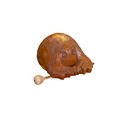
- Ritual Vessel: Muyu (Woodblock)
Like the dangzi, the muyu woodblock is a ritual percussion instrument. It is sounded by knocking a hollow woodblock resembling a fish with a wooden hammer. In a salvation ritual, the muyu is usually played by the Chief Cantor in tandem with the Inspector of Fasts who plays the dangzi to pace the scripture chanting.
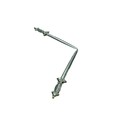
- Ritual Vessel: Magical Sword
During a salvation ritual, the high priest opens the gate to the netherworld with the magical sword in accordance with Taoist ways, so that the dead can leave hell for the world of the living to hear the chanting of scriptures.

- Ritual Vessel: Water Jar
The water jar is a ritual vessel for purifying the place where the rites are held. The high priest turns the water in the water jar into sacred water according to Taoist ways. While he reads aloud the incantation Jing Tiandi Shenzhou, he sprays ritual water with pomelo leaves to purify the ritual place.
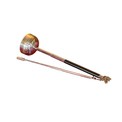
- Ritual Vessel: Yinqing (Guiding Chime)
The yinqing consists of an inverted bell and a rod-shaped mallet, sounded by hitting the mallet against the bell. It has two functions: one is to show piety when extolling the gods and their sacred titles, and the other is to synchronise the movements of ritual masters during worship.
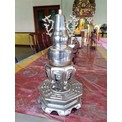
- Ritual Vessel: Alchemy Stove
During a salvation ritual, the ritual master cooks the rice with the alchemy stove on the spot, and then turns it into food consumable for the hungry ghosts according to Taoist ways. Cast from tin, this implement has a hollow design so water can be poured into it to cook rice. The base is decorated with King Wen’s Eight-trigram.
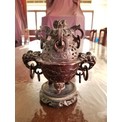
- Vessel for Offerings: Incense Burner
The incense burner is a holder for incense. The Taoist incantation Zhu Xiang Zhou, or Incantation with Incense Offerings, says, “Tao is learnt through the heart; the incense is the conduit”. Burning incense is an important step in the ritual for evoking the gods and expressing one’s wishes.